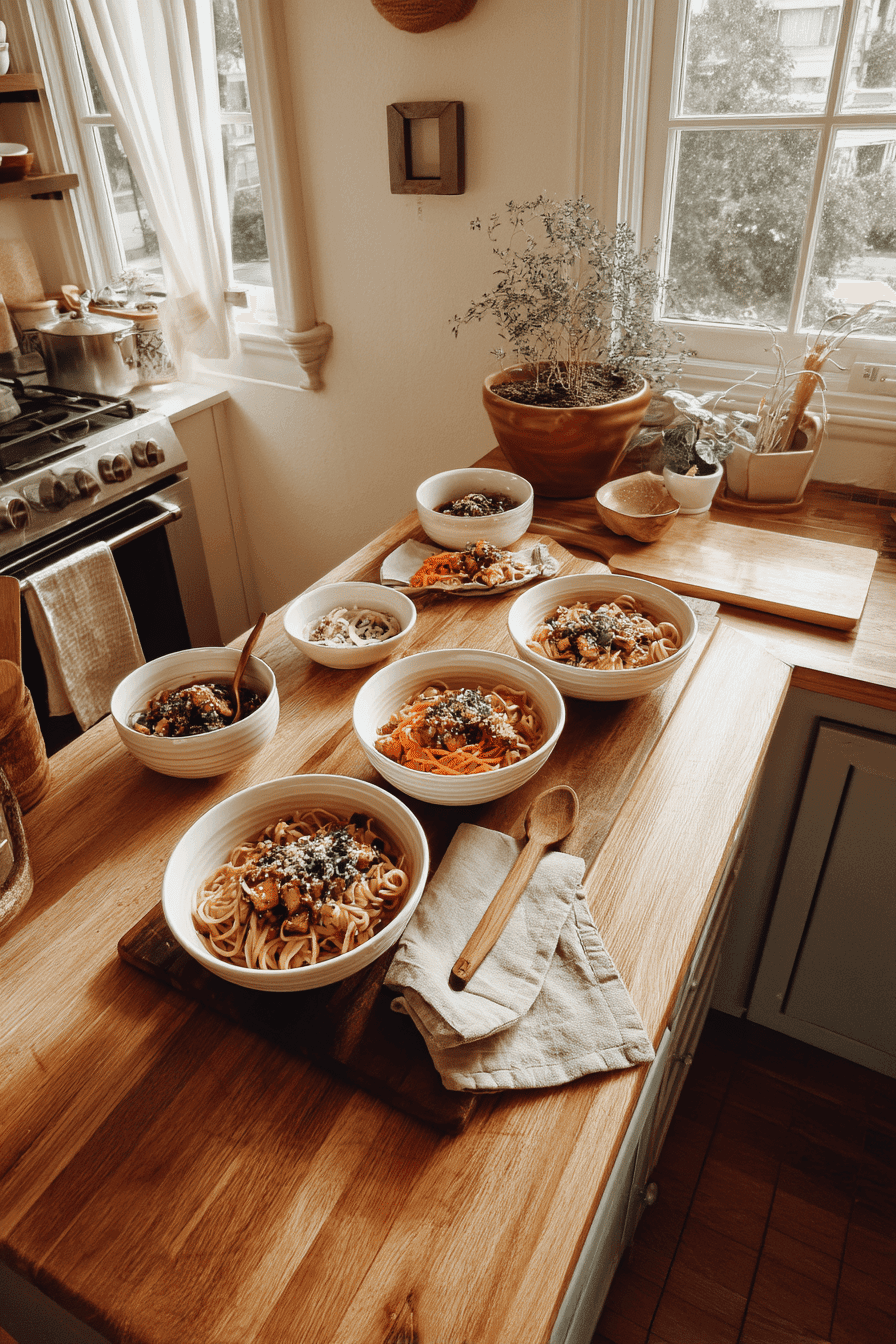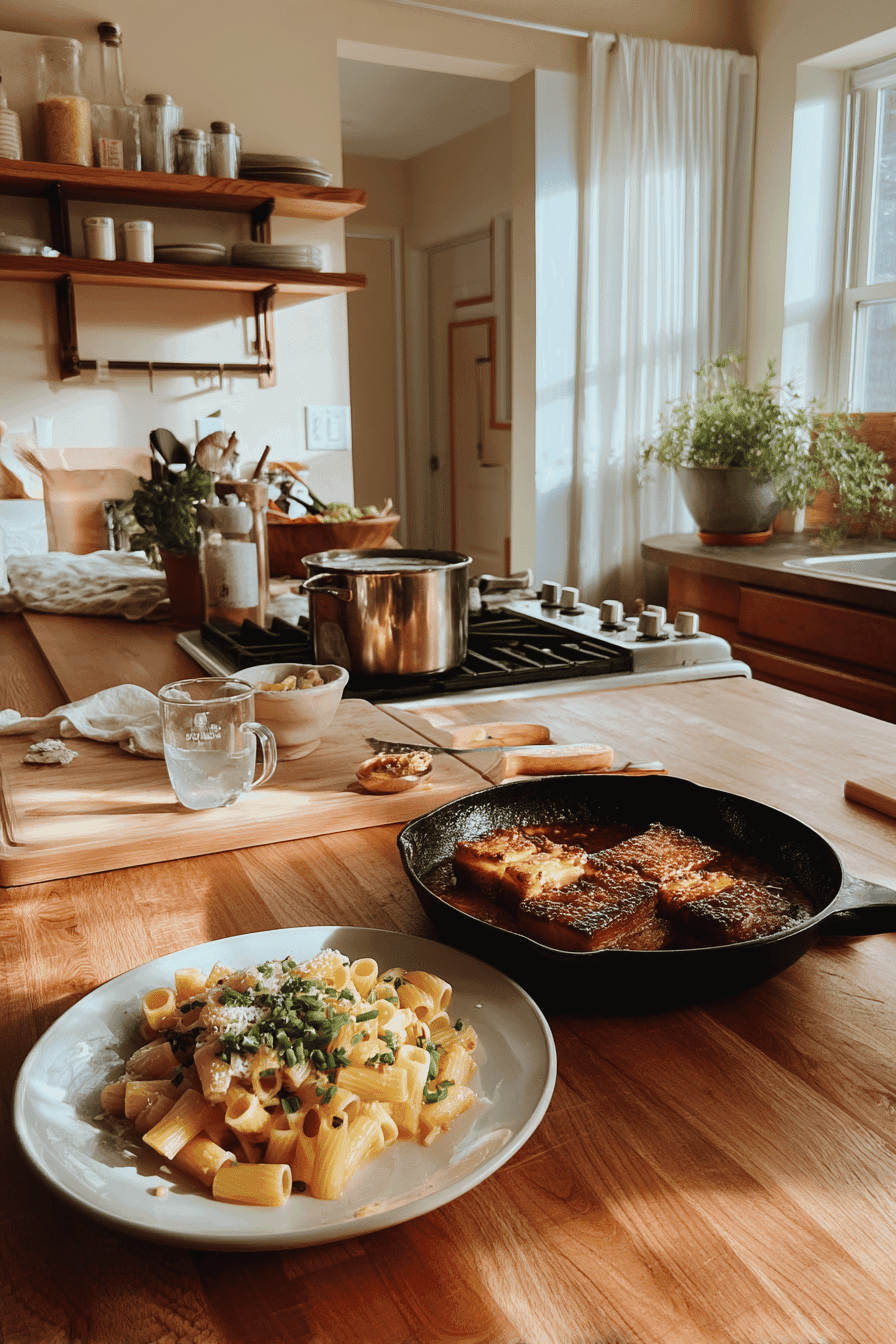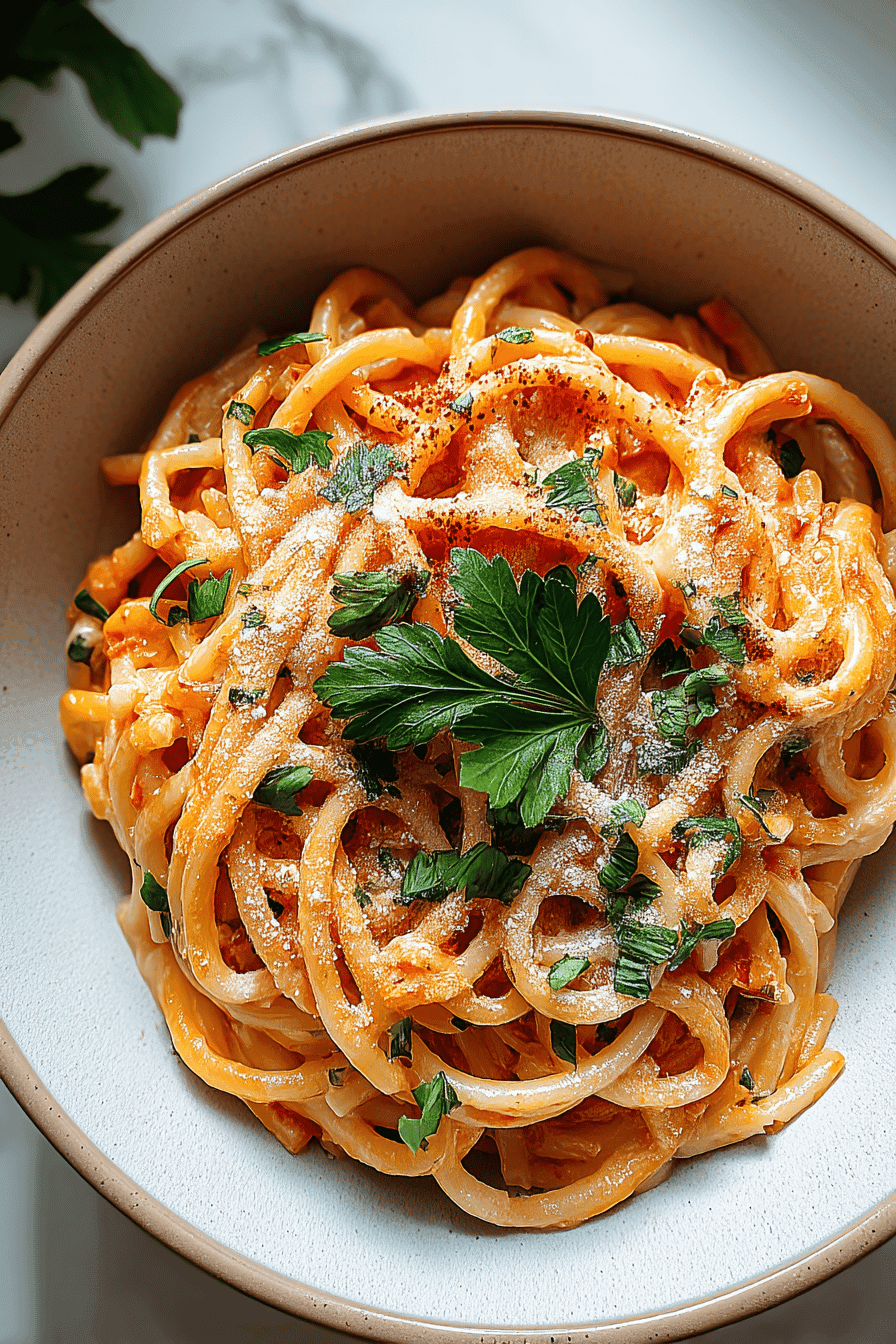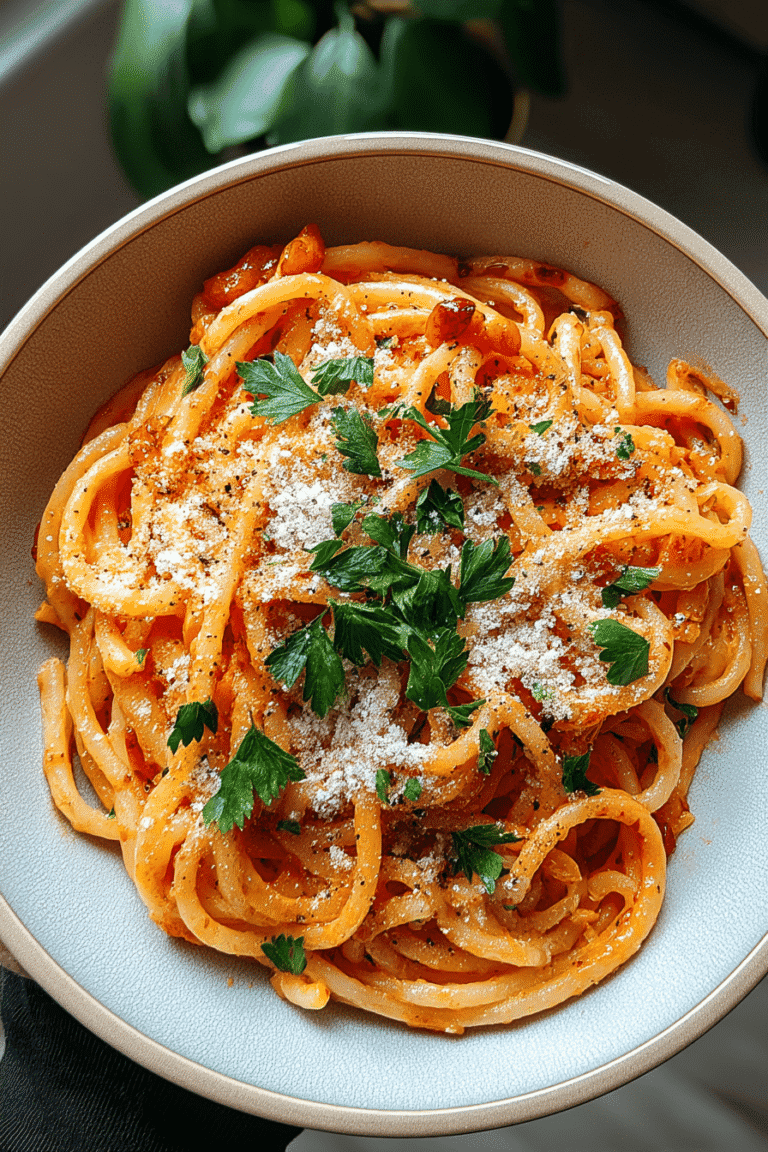Benefits and Advantages of gochujang pasta
Gochujang pasta offers a unique fusion of spicy, sweet, and savory flavors that make it a delightful choice for those craving bold tastes. Its primary advantage lies in its simple and quick preparation, perfect for busy home cooks needing a satisfying meal in under 30 minutes. The Korean fermented chili paste, gochujang, enriches the dish not only with complex, layered flavors but also with beneficial nutrients such as vitamins, antioxidants, and probiotics that support digestive health.
Another notable benefit is the recipe’s versatility: the spice level and ingredients can be easily adjusted to accommodate dietary preferences like vegan or gluten-free diets, expanding its appeal. Gochujang pasta serves as a healthy alternative to heavier pasta dishes, combining creaminess from dairy with the distinctive kick of fermented chili paste for a well-rounded, flavorful meal.
Jump to:
- Benefits and Advantages of gochujang pasta
- Essential Ingredients for gochujang pasta
- Dietary Substitutions to Customize Your gochujang pasta
- How to Prepare the Perfect gochujang pasta: Step-by-Step Guide
- Mastering gochujang pasta: Advanced Tips and Variations
- How to Store gochujang pasta: Best Practices
- Nutritional Value of gochujang pasta
- FAQs: Frequently Asked Questions About gochujang pasta
- What is the best type of gochujang to use for making gochujang pasta?
- How do I cook pasta perfectly for gochujang pasta recipes?
- What does gochujang taste like and how does it affect the flavor of pasta?
- Can I adjust the gochujang pasta recipe for a single serving, and how?
- How can I measure sticky gochujang paste accurately when cooking?
- Spicy Gochujang Noodles with Creamy Butter Sauce Recipe
- Ingredients
- Instructions
- Last Step:
- Notes
- Nutrition
- Did you make this recipe?
Essential Ingredients for gochujang pasta
- 200 grams dry rigatoni or preferred pasta (gluten-free alternatives available)
- 50 grams pork belly or 3 slices bacon (for protein; can be omitted for vegetarian versions)
- 5 cloves garlic, thinly sliced
- 2.5 tablespoons gochujang paste (Korean fermented chili paste)
- ¾ cup milk
- ¼ cup heavy cream
- ½ tablespoon soy sauce (or tamari for gluten-free)
- ½ cup reserved starchy pasta water
- Optional garnishes: grated parmesan cheese, chopped chives, or green onions
These ingredients create a balanced sauce that is creamy, spicy, and savory. The gochujang paste is the star, delivering bold flavors while the dairy components balance heat with richness.

Dietary Substitutions to Customize Your gochujang pasta
Gochujang pasta is flexible and can be adapted for various dietary needs:
- Gluten-Free: Use gluten-free pastas made from rice, corn, or chickpeas to replace regular pasta and tamari instead of soy sauce.
- Vegan: Swap pork belly for tofu or tempeh; replace heavy cream with coconut cream or plant-based cream alternatives; use maple syrup or agave in place of honey if added for sweetness.
- Low-Carb: Substitute pasta with spiralized vegetables like zucchini or shirataki noodles to cut carbohydrates and increase fiber.
- Lower Sodium: Use low-sodium soy sauce or coconut aminos and moderate the amount of gochujang for a milder flavor and less salt content.
Adjust heat levels by adding more or less gochujang and balance spice with sweeteners like maple syrup or agave. These substitutions keep the dish true to its character while expanding accessibility to diverse diets.

How to Prepare the Perfect gochujang pasta: Step-by-Step Guide
- Cook Pasta: Bring a large pot of salted water to a boil, cook 200g pasta according to package instructions until al dente, typically 10-15 minutes. Reserve ½ cup pasta water before draining.
- Cook Pork Belly: Cut pork belly into 1-inch pieces. In a pan over medium heat, brown for 3-5 minutes per side until crispy. Remove pork but leave about 1 tablespoon of the rendered fat in the pan.
- Sauté Garlic: Add sliced garlic to the pork fat and sauté for about 30 seconds until fragrant.
- Make Sauce: Stir in 2.5 tablespoons gochujang paste and cook for 1 minute to release flavors. Add ¾ cup milk, ¼ cup heavy cream, and ½ tablespoon soy sauce. Simmer gently for about 3 minutes to thicken slightly.
- Combine Pasta and Sauce: Return the cooked pasta and pork belly to the pan. Add reserved pasta water gradually, stirring over medium heat for 2-3 minutes, until sauce coats pasta and reaches desired consistency.
- Serve: Remove from heat and garnish with grated parmesan cheese and chopped chives or green onions if desired.
This step-by-step process ensures a creamy, spicy, and rich pasta dish perfectly balanced and customizable to your preferences.
Mastering gochujang pasta: Advanced Tips and Variations
Enhance your gochujang pasta by toasting sesame seeds before adding them as a garnish, which releases a rich, nutty aroma. For extra heat, sprinkle crushed red pepper flakes into the sauce or alongside the dish. Roasted vegetables like bell peppers, zucchini, or mushrooms provide texture contrast and additional nutrition while harmonizing with the spicy Korean flavor profile.
To achieve creaminess with a silky texture, stir in a splash of coconut milk or plant-based cream to mellow the spiciness. Vary your protein by trying shrimp, beef strips, or tempeh, which can be marinated in gochujang and soy sauce to deepen flavor before cooking. When preparing gluten-free meals, ensure all sauces and ingredients are certified gluten-free to maintain dietary compliance. These tips preserve the bold, fermented chili paste taste while allowing you to tailor the dish creatively. Using terms like “fermented chili paste pasta” and “Korean spicy sauce” naturally supports SEO optimization and reader engagement.
How to Store gochujang pasta: Best Practices
To keep gochujang pasta fresh and flavorful, refrigerate leftovers in an airtight container within two hours of cooking and consume within 3-4 days. When freezing, portion the pasta into meal-sized containers, allowing space for expansion, and store for up to two months. Thaw frozen portions overnight in the refrigerator.
Reheat gently over low heat on the stove, adding a splash of water or broth to loosen the sauce if it appears thickened from refrigeration. Stirring during reheating restores the creamy sauce consistency. Avoid multiple freeze-thaw cycles as this can diminish texture and flavor intensity of the fermented chili paste. Proper storage practices preserve the vibrant, spicy flavors characteristic of gochujang pasta, making it convenient for future meals.
Storing and reheating thoughtfully ensures every bite of your gochujang pasta remains just as delicious as when freshly made.
Nutritional Value of gochujang pasta
| Nutrient | Approximate Amount per Serving | Health Benefit |
|---|---|---|
| Calories | 400-500 kcal | Provides balanced energy primarily from carbohydrates and moderate protein |
| Protein | 15-25 g | Supports muscle health and satiety, depending on added proteins |
| Fat | Low to moderate, mostly unsaturated from sesame oil | Promotes cardiovascular health and nutrient absorption |
| Vitamins A & C | Present | Antioxidants contribute to immune support and skin health |
| Dietary Fiber | Varies by pasta choice | Enhances digestive health and sustained fullness |
| Sodium | Adjustable based on soy sauce choice | Lower sodium options contribute to heart health |
This dish offers a nourishing balance of macronutrients and antioxidants through its unique blend of spicy sauces and protein sources. For more insight into What is Gochujang?, visit this detailed guide.

FAQs: Frequently Asked Questions About gochujang pasta
What is the best type of gochujang to use for making gochujang pasta?
How do I cook pasta perfectly for gochujang pasta recipes?
What does gochujang taste like and how does it affect the flavor of pasta?
Can I adjust the gochujang pasta recipe for a single serving, and how?
How can I measure sticky gochujang paste accurately when cooking?

Spicy Gochujang Noodles with Creamy Butter Sauce Recipe
🌶️ Dive into the rich flavors of Spicy Gochujang Noodles with creamy butter sauce for a tantalizing taste experience.
🍜 Perfect for a quick weeknight dinner, this dish combines Korean heat with a creamy pasta twist.
- Total Time: 20 minutes
- Yield: 2 servings 1x
Ingredients
200 grams dry rigatoni or pasta of choice
50 grams pork belly or 3 slices bacon
5 cloves garlic, sliced
2.5 tablespoons gochujang paste
¾ cup milk
¼ cup heavy cream
½ tablespoon soy sauce
½ cup reserved starchy pasta water
Optional garnishes: parmesan cheese and chopped chives or green onions
Instructions
1. Cook rigatoni in salted boiling water until al dente (about 10-15 minutes). Reserve ½ cup pasta water before draining.
2. Cut pork belly into 1-inch pieces and brown in a pan over medium heat for 3-5 minutes per side until crispy. Remove pork but leave about 1 tablespoon of rendered fat in the pan.
3. Add sliced garlic to the fat and sauté for 30 seconds until fragrant.
4. Stir in gochujang and cook for about 1 minute to release aromas and deepen flavor.
5. Pour in milk, heavy cream, and soy sauce, then simmer for 3 minutes until slightly thickened. Keep sauce on low heat if pasta is not ready.
6. Return cooked rigatoni, pork belly, and reserved pasta water to the sauce. Simmer over medium heat, stirring frequently, for 2-3 minutes until the sauce coats the pasta well and reaches desired consistency.
7. Remove from heat and, if desired, top with grated parmesan cheese and chopped chives or green onions before serving.
Last Step:
Please leave a rating and comment letting us know how you liked this recipe! This helps our business to thrive and continue providing free, high-quality recipes for you.Notes
🍝 Use pasta with ridges, such as rigatoni or penne, for better sauce adherence.
🥛 The combination of milk and cream lightens the sauce, preventing heaviness but maintaining creaminess.
💧 Don’t rinse pasta to keep starches that help thicken and cling to the sauce.
- Prep Time: 5 minutes
- None: 0 minutes
- Cook Time: 15 minutes
- Category: Dinner
- Method: Stovetop
- Cuisine: Korean Fusion
- Diet: Non-Vegetarian
Nutrition
- Serving Size: 1/2 of recipe
- Calories: value unavailable
- Sugar: value unavailable
- Sodium: value unavailable
- Fat: value unavailable
- Saturated Fat: value unavailable
- Unsaturated Fat: value unavailable
- Trans Fat: value unavailable
- Carbohydrates: value unavailable
- Fiber: value unavailable
- Protein: value unavailable
- Cholesterol: value unavailable







